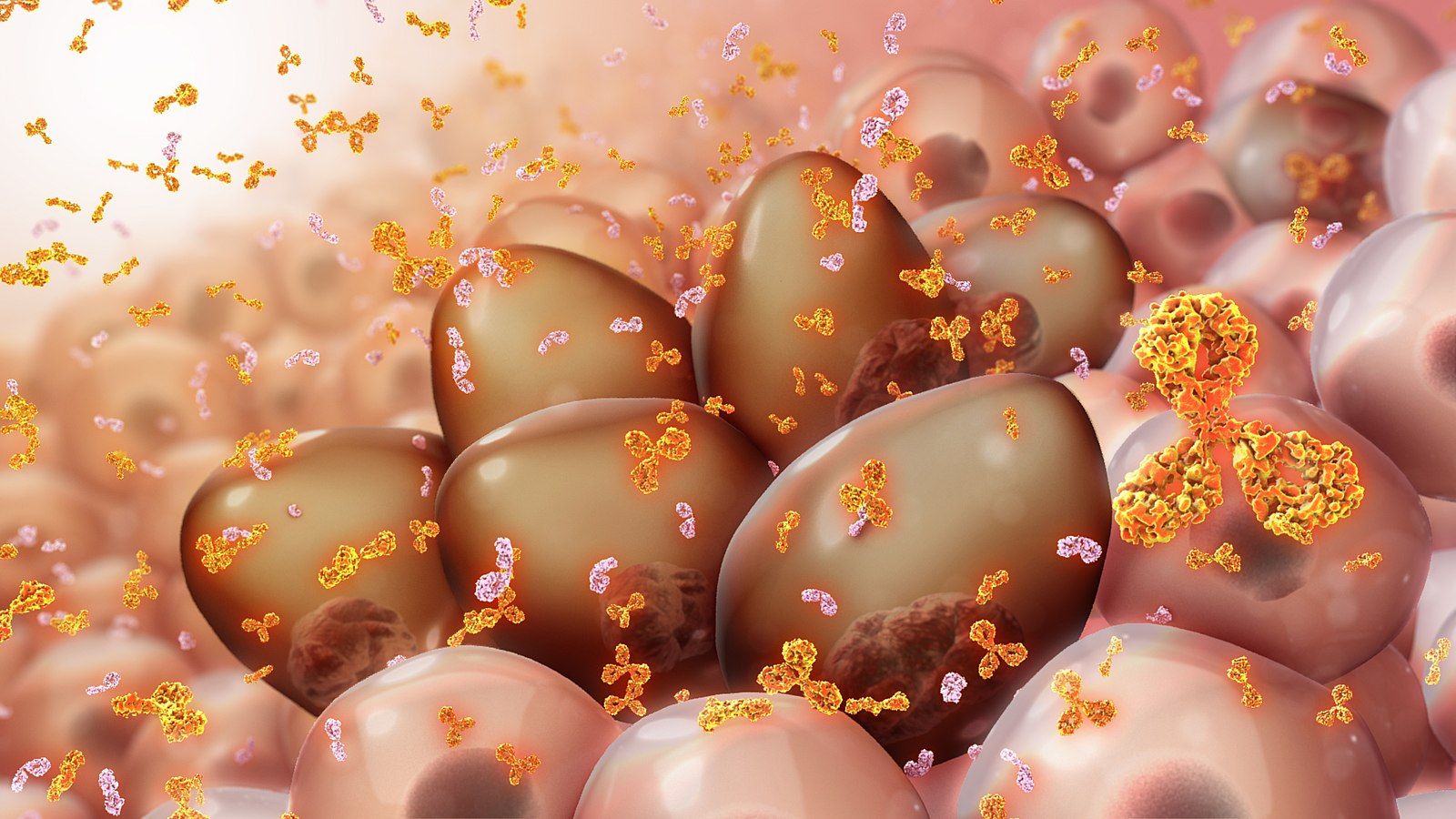Subgroup Analysis Data Support Daratumumab Combo PFS Benefit in NDMM
A subgroup analysis from the PERSEUS trial showed sustained PFS benefit in patients with newly diagnosed multiple myeloma receiving D-VRd.
“The PERSEUS regimen demonstrates improved MRD negativity and PFS outcomes in patients with high-risk cytogenetics, including gain (1q21) and with 2 or more high-risk cytogenetic abnormalities,” according to study author Meletios A. Dimopoulos, MD.

Subcutaneous daratumumab (Darzalex) plus bortezomib (Velcade), lenalidomide (Revlimid), and dexamethasone (D-VRd) as induction or consolidation therapy with lenalidomide maintenance showed positive progression-free survival (PFS) with longer rates of minimal residual disease (MRD) negativity for patients with newly diagnosed multiple myeloma, according to cytogenetic risk analysis results from the phase 3 PERSEUS trial (NCT03710603) presented at the 2024 International Myeloma Society Annual Meeting.
In the intent-to-treat population, PFS was not evaluable (NE) across all major subgroups with D-VRd. Specifically, those with revised standard risk were brought to attention (HR, 0.29; 95% CI, 0.15-0.56; P = .0001). Of note, PFS was favored with D-VRd followed by D-R maintenance.
“The PERSEUS regimen demonstrates improved MRD negativity and PFS outcomes in patients with high-risk cytogenetics, including gain (1q21) and with 2 or more high-risk cytogenetic abnormalities,” Meletios A. Dimopoulos, MD, professor and chairman of the Department of Clinical Therapeutics at the National and Kapodistrian University of Athens School of Medicine, said during the presentation.
Overall, 709 patients were randomly assigned to the VRd (n = 354) or D-VRd (n = 355) arms. During induction, bortezomib was given at 1.3 mg/m2 subcutaneously on days 1, 4, 8, and 11; plus, lenalidomide at 25 mg orally on days 1 to 21; dexamethasone at 40 mg orally or intravenously on days 1 to 4 and 9 to 12; and daratumumab at 1800 mg subcutaneously every week during cycles 1 to 2 and every 2 weeks during cycles 3 to 4. Patients then went to single transplant and received consolidation therapy with matched dosing.
During maintenance, the VRd group was given lenalidomide at 10 mg orally on days 1 to 28 until disease progression. The D-VRd group was given daratumumab at 1800 mg subcutaneously every 4 weeks plus lenalidomide at 10 mg orally on days 1 to 28. If patients were MRD-positive, they continued to D-R until progression. If patients were MRD-negative, they stopped daratumumab and continued lenalidomide. Daratumumab was restarted when there was a confirmed loss of complete response (CR) without progressive disease or recurrence of MRD.
The primary end point was PFS. Secondary end points included overall CR or better rate, overall MRD-negativity rate, and overall survival.
R2-International Staging System (ISS) disease states were assessed. Between both arms, among patients with low (HR, 0.42; 95% CI, 0.16-1.11), low-intermediate (HR, 0.29; 95% CI, 0.14-0.57), intermediate-high (HR, 0.46; 95% CI, 0.29-0.75), and high disease stage (HR, 0.63; 95% CI, 0.25-1.61), the median PFS was NE.
Dimopoulos noted that when daratumumab was added, the PFS was extended despite R2-ISS disease stage, and there was a more pronounced benefit for those with stage II and III disease.
The analysis then went through various subgroups based on MRD negativity at 10-5, with outcomes generally favoring D-VRd followed by D-R. MRD negativity at 10-5 with a CR or better in the D-VRd and VRd arms, respectively, was highlighted in patients with standard-risk (77.3% vs 48.1%; odds ratio [OR], 3.67; 95% CI, 2.52-5.33), high-risk (68.4% vs 47.4%; OR, 2.40; 95% CI, 1.24-4.63), revised standard-risk (75.3% vs 47.3%; OR, 3.39; 2.14-5.37), and revised high-risk disease (73.1% vs 49.3%; OR, 2.79; 95% CI, 1.68-4.62).
The subgroup analysis also looked at sustained MRD negativity at 10-5 for 12 months, which evaluated patients with standard-risk (69.3% vs 31.2%; OR, 4.98; 95% CI, 3.45-7.20), high-risk (48.7% vs 25.6%; OR, 2.75; 95% CI, 1.40-5.42), revised standard-risk (66.1% vs 31.7%; OR, 4.19; 95% CI, 2.67-6.59), and revised high-risk disease (59.2% vs 27.7%; OR, 3.79; 95% CI, 2.30-6.26). These were evaluated in the D-VRd and VRd arms, respectively.
The rate of MRD negativity at 10-6 with CR or better was evaluated across different cytogenetic risk statuses. Between both arms, analysis was conducted for standard-risk (67.0% vs 33.1%; OR, 4.12; 95% CI, 2.87-5.91), high-risk (57.9% vs 30.8%; OR, 3.09; 95% CI, 1.60-6.00), revised standard-risk (66.1% vs 33.5%; OR, 3.86; 95% CI, 2.47-6.05), and revised high-risk disease (63.1% vs 32.4%; OR, 3.56; 95% CI, 2.17-5.84).
Investigators assessed rates of CR or better and MRD negativity at 10-5 for patietnts with R2-ISS low (79.3% vs 48.7%; OR, 4.11; 95% CI, 2.30-7.35), low-intermediate (75.7% vs 46.2%; OR, 3.62; 95% CI, 2.03-6.45), intermediate-high (73.1% vs 47.8%; OR, 2.97; 95% CI,1.70-5.21), and high disease (60.0% vs 47.4%; OR, 1.67; 95% CI, 0.47-5.93).
Similarly, results were assessed with R2-ISS for sustained MRD negativity at 10-5 for 12 months or more in the D-VRd and VRd arms, respectively. Stages evaluated were low (70.7% vs 33.3%; OR, 4.82; 95% CI, 2.76-8.43), low-intermediate (68.5% vs 25.5%; OR, 6.35; 95% CI, 3.51-11.49), intermediate-high (58.3% vs 31.3%; OR, 3.07; 95% CI, 1.77-5.32), and high (45.0% vs 21.1%; OR, 3.07; 95% CI, 0.75-12.59).
Analysis for MRD negativity at 10-6 with CR or better between the D-VRd and VRd arms included patients with R2-ISS low (67.2% vs 32.5%; OR, 4.27; 95% CI, 2.46-7.41), low-intermediate (68.5% vs 29.2%; OR, 5.25; 95% CI, 2.94-9.38), intermediate-high (60.2% vs 34.8%; 95% CI, 2.83; 95% CI, 1.65-1.88), and high disease (60.0% vs 31.6%; OR, 3.25; 95% CI, 0.87-12.14).
For those with sustained MRD negativity at 10-6 for 12 or more months, the analysis rates included RS-ISS low (50.0% vs 21.1%; OR, 3.75; 95% CI, 2.10-6.69), low-intermediate (50.5% vs 17.0%; OR, 4.98; 95% CI, 2.65-9.34), intermediate-high (43.5% vs 19.1%; OR, 3.26; 95% CI, 1.79-5.94), and high disease (35.0% vs 10.5%; 95% CI, 4.58; 95% CI, 0.81-25.80).
Reference
Dimopoulos MA, Sonneveld P, Rodriguez-Otero P, et al. Daratumumab (DARA)/Bortezomib/Lenalidomide/ Dexamethasone (D-VRd) With D-R Maintenance (Maint) in Transplant-eligible (TE) Newly Diagnosed Myeloma (NDMM): PERSEUS Cytogenetic Risk Analysis. Presented at the 2024 International Myeloma Society Annual Meeting; September 25-28, 2024; Rio De Janeiro, Brazil. Abstract OA-48.